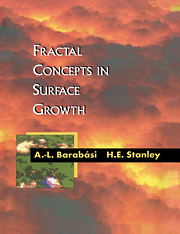Book contents
- Frontmatter
- Contents
- Preface
- Notation guide
- PART 1 Introduction
- PART 2 Nonequilibrium roughening
- PART 3 Interfaces in random media
- 9 Basic phenomena
- 10 Quenched noise
- 11 Experiments
- PART 4 Molecular beam epitaxy
- PART 5 Noise
- PART 6 Advanced topics
- PART 7 Finale
- APPENDIX A Numerical recipes
- APPENDIX B Dynamic renormalization group
- APPENDIX C Hamiltonian description
- Bibliography
- Index
9 - Basic phenomena
Published online by Cambridge University Press: 23 December 2009
- Frontmatter
- Contents
- Preface
- Notation guide
- PART 1 Introduction
- PART 2 Nonequilibrium roughening
- PART 3 Interfaces in random media
- 9 Basic phenomena
- 10 Quenched noise
- 11 Experiments
- PART 4 Molecular beam epitaxy
- PART 5 Noise
- PART 6 Advanced topics
- PART 7 Finale
- APPENDIX A Numerical recipes
- APPENDIX B Dynamic renormalization group
- APPENDIX C Hamiltonian description
- Bibliography
- Index
Summary
In previous chapters, we focused on interfaces that grow and roughen due to thermal fluctuations, the origin of the randomness arising from the random nature of the deposition process. For a class of interface phenomena, however, we do not have deposition, but rather we have an interface that moves in a disordered medium. The experiment described in Chapter 1 in which a fluid interface propagates through a paper towel is one example. The velocity of the interface is affected by the inhomogeneities of the medium: the resistance of the medium against the flow is different from point to point; we call this quenched noise, because it does not change with time. Fluid pressure and capillary force drive the fluid, and disorder in the medium slows its propagation. If the disorder ‘wins’ the competition, the interface becomes ‘pinned.’ Conversely, if the driving forces win, the interface stays ‘depinned.’ This transition from a pinned to a moving interface – obtained by changing the driving force – is called the depinning transition.
In the following three chapters, we discuss how quenched disorder leads to interface pinning – and depinning. We will show that the same theoretical ideas describe interface motion in a random field Ising model, which is relevant to the problem of domain growth in a disordered magnetic material.
The problem of a moving interface in the presence of quenched noise is a new type of critical phenomena, arising from ‘quenched randomness.’
- Type
- Chapter
- Information
- Fractal Concepts in Surface Growth , pp. 91 - 98Publisher: Cambridge University PressPrint publication year: 1995
- 2
- Cited by



